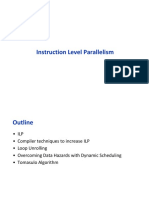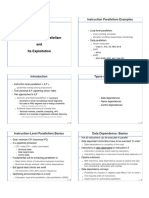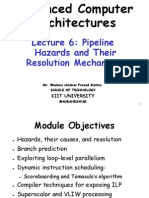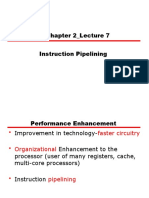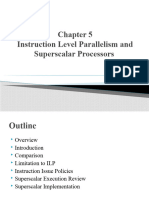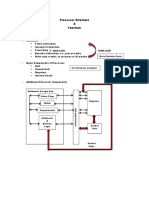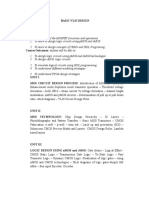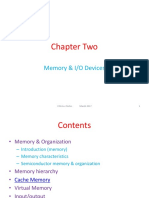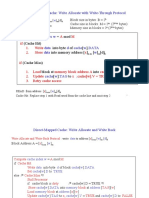Instruction Level Pipelining
Uploaded by
GowriInstruction Level Pipelining
Uploaded by
GowriComputer Architecture
A Quantitative Approach, Fifth Edition
Chapter 3
Instruction-Level Parallelism
and Its Exploitation
Copyright © 2012, Elsevier Inc. All rights reserved. 1
Contents
1. Pipelining; hazards
2. ILP - data, name, and control dependence
3. Compiler techniques for exposing ILP: Pipeline scheduling,
Loop unrolling, Strip mining, Branch prediction
4. Register renaming
5. Multiple issue and static scheduling
6. Speculation
7. Energy efficiency
8. Multi-threading
9. Fallacies and pitfalls
10. Exercises
Copyright © 2012, Elsevier Inc. All rights reserved. 2
Introduction
Introduction
Pipelining become universal technique in 1985
Overlaps execution of instructions
Exploits “Instruction Level Parallelism (ILP)”
Two main approaches:
Dynamic hardware-based
Used in server and desktop processors
Not used as extensively in Parallel Multiprogrammed
Microprocessors (PMP)
Static approaches compiler-based
Not as successful outside of scientific applications
Copyright © 2012, Elsevier Inc. All rights reserved. 3
Review of basic concepts
Pipelining each instruction is split up into a sequence of
steps – different steps can be executed concurrently by
different circuitry.
A basic pipeline in a RISC processor
IF – Instruction Fetch
ID – Instruction Decode
EX – Instruction Execution
MEM – Memory Access
WB – Register Write Back
Two techniques:
Superscalar A superscalar processor executes more than one
instruction during a clock cycle.
VLIW very long instruction word – compiler packs multiple
independent operations into an instruction
dcm 4
Basic superscalar 5-stage pipeline
Superscalar a processor executes more than one instruction during a
clock cycle by simultaneously dispatching multiple instructions to
redundant functional units on the processor.
The hardware determines (statically/ dynamically) which one of a block on
n instructions will be executed next.
A single-core superscalar processor SISD
A multi-core superscalar MIMD.
Copyright © 2012, Elsevier Inc. All rights reserved. 5
Hazards pipelining could lead to incorrect results.
Data dependence “true dependence” Read after Write hazard (RAW)
i: sub R1, R2, R3 % sub d,s,t d =s-t
i+1: add R4, R1, R3 % add d,s t d = s+t
Instruction (i+1) reads operand (R1) before instruction (i) writes it.
Name dependence “anti dependence” two instructions use the same
register or memory location, but there is no data dependency between them.
Write after Read hazard (WAR) Example:
i: sub R4, R5, R3
i+1: add R5, R2, R3
i+2: mul R6, R5, R7
Instruction (i+1) writes operand (R5) before instruction (i) reads it.
Write after Write (WAW) (Output dependence) Example
i: sub R6, R5, R3
i+1: add R6, R2, R3
i+2: mul R1, R2, R7
Instruction (i+1) writes operand (R6) before instruction (i) writes it.
dcm 6
More about hazards
Data hazards RAW, WAR, WAW.
Structural hazard occurs when a part of the processor's hardware is
needed by two or more instructions at the same time. Example: a single
memory unit that is accessed both in the fetch stage where an instruction
is retrieved from memory, and the memory stage where data is written
and/or read from memory. They can often be resolved by separating the
component into orthogonal units (such as separate caches) or bubbling
the pipeline.
Control hazard (branch hazard) are due to branches. On many
instruction pipeline microarchitectures, the processor will not know the
outcome of the branch when it needs to insert a new instruction into the
pipeline (normally the fetch stage).
Copyright © 2012, Elsevier Inc. All rights reserved. 7
Introduction
Instruction-level parallelism (ILP)
When exploiting instruction-level parallelism, goal is to
maximize CPI
Pipeline CPI =
Ideal pipeline CPI +
Structural stalls +
Data hazard stalls +
Control stalls
Parallelism with basic block is limited
Typical size of basic block = 3-6 instructions
Must optimize across branches
Copyright © 2012, Elsevier Inc. All rights reserved. 8
Introduction
Data dependence
Loop-Level Parallelism
Unroll loop statically or dynamically
Use SIMD (vector processors and GPUs)
Challenges:
Data dependency
Instruction j is data dependent on instruction i if
Instruction i produces a result that may be used by instruction j
Instruction j is data dependent on instruction k and instruction k
is data dependent on instruction i
Dependent instructions cannot be executed
simultaneously
Copyright © 2012, Elsevier Inc. All rights reserved. 9
Introduction
Data dependence
Dependencies are a property of programs
Pipeline organization determines if dependence
is detected and if it is s causes a “stall.”
Data dependence conveys:
Possibility of a hazard
Order in which results must be calculated
Upper bound on exploitable instruction level
parallelism
Dependencies that flow through memory
locations are difficult to detect
Copyright © 2012, Elsevier Inc. All rights reserved. 10
Introduction
Name dependence
Two instructions use the same name but no flow
of information
Not a true data dependence, but is a problem when
reordering instructions
Antidependence: instruction j writes a register or
memory location that instruction i reads
Initial ordering (i before j) must be preserved
Output dependence: instruction i and instruction j
write the same register or memory location
Ordering must be preserved
To resolve, use renaming techniques
Copyright © 2012, Elsevier Inc. All rights reserved. 11
Introduction
Control dependence
Every instruction is control dependent on some set of
branches and, in general, the control dependencies must be
preserved to ensure program correctness.
Instruction control dependent on a branch cannot be moved before
the branch so that its execution is no longer controller by the branch.
An instruction not control dependent on a branch cannot be moved
after the branch so that its execution is controlled by the branch.
Example
if C1 {
S1;
};
if C2 {
S2;
};
S1 is control dependent on C1; S2 is control dependent on C2 but not on C1
Copyright © 2012, Elsevier Inc. All rights reserved. 12
Properties essential to program correctness
Preserving exception behavior any change in instruction order must not
change the order in which exceptions are raised. Example:
DADDU R1, R2, R3
BEQZ R1, L1
L1 LW R4, 0(R1)
Can we move LW before BEQZ ?
Preserving data flow the flow of data between instructions that produce
results and consumes them. Example:
DADDU R1, R2, R3
BEQZ R4, L1
DSUBU R1, R8, R9
L1 LW R5, 0(R2)
OR R7, R1, R8
Does OR depend on DADDU and DSUBU?
dcm 13
Introduction
Examples
• Example 1: OR instruction dependent
DADDU R1,R2,R3 on DADDU and DSUBU
BEQZ R4,L
DSUBU R1,R1,R6
L: …
OR R7,R1,R8
• Example 2: Assume R4 isn’t used after
DADDU R1,R2,R3 skip
BEQZ R12,skip
Possible to move DSUBU
DSUBU R4,R5,R6
before the branch
DADDU R5,R4,R9
skip:
OR R7,R8,R9
Copyright © 2012, Elsevier Inc. All rights reserved. 14
Compiler techniques for exposing ILP
Loop transformation technique to optimize a program's execution speed:
1. reduce or eliminate instructions that control the loop, e.g., pointer
arithmetic and "end of loop" tests on each iteration
2. hide latencies, e.g., the delay in reading data from memory
3. re-write loops as a repeated sequence of similar independent
statements space-time tradeoff
4. reduce branch penalties;
Methods
1. pipeline scheduling
2. loop unrolling
3. strip mining
4. branch prediction
Copyright © 2012, Elsevier Inc. All rights reserved. 15
Compiler Techniques
1. Pipeline scheduling
Pipeline stall delay in execution of an instruction in an instruction
pipeline in order to resolve a hazard. The compiler can reorder
instructions to reduce the number of pipeline stalls.
Pipeline scheduling Separate dependent instruction from the
source instruction by the pipeline latency of the source instruction
Example:
for (i=999; i>=0; i=i-1)
x[i] = x[i] + s;
Copyright © 2012, Elsevier Inc. All rights reserved. 16
Compiler Techniques
Pipeline stalls
Assumptions:
1. S F2
2. The element of the array with the highest address R1
3. The element of the array with the lowest address +8 R2
Loop: L.D F0,0(R1) % load array element in F0
stall % next instruction needs the result in F0
ADD.D F4,F0,F2 % increment array element
stall
stall % next instruction needs the result in F4
S.D F4,0(R1) % store array element
DADDUI R1,R1,#-8 % decrement pointer to array element
stall (assume integer load latency is 1) % next instruction needs result in R1
BNE R1,R2,Loop % loop if not the last element
Copyright © 2012, Elsevier Inc. All rights reserved. 17
Compiler Techniques
Pipeline scheduling
Scheduled code:
Loop: L.D F0,0(R1)
DADDUI R1,R1,#-8
ADD.D F4,F0,F2
stall
stall
S.D F 4,8(R1)
BNE R1,R2,Loop
Copyright © 2012, Elsevier Inc. All rights reserved. 18
2. Loop unrolling
Given the same code
Loop: L.D F0,0(R1)
DADDUI R1,R1,#-8
ADD.D F4,F0,F2
S.D F4,8(R1)
BNE R1,R2,Loop
Assume # elements of the array with starting address in R1 is
divisible by 4
Unroll by a factor of 4
Eliminate unnecessary instructions.
dcm 19
Compiler Techniques
Unrolled loop
Loop: L.D F0,0(R1)
ADD.D F4,F0,F2
S.D F4,0(R1) % drop DADDUI & BNE
L.D F6,-8(R1)
ADD.D F8,F6,F2
S.D F8,-8(R1) %drop DADDUI & BNE
L.D F10,-16(R1)
ADD.D F12,F10,F2
S.D F12,-16(R1) % drop DADDUI & BNE
L.D F14,-24(R1)
ADD.D F16,F14,F2
S.D F16,-24(R1)
DADDUI R1,R1,#-32
BNE R1,R2,Loop
Live registers: F0-1, F2-3, F4-5, F6-7, F8-9,F10-11, F12-13, F14-15,
and F16-15; also R1 and R2
In the original code: only F0-1, F2-3, and F4-5; also R1 and R2
Copyright © 2012, Elsevier Inc. All rights reserved. 20
Compiler Techniques
Pipeline schedule the unrolled loop
Loop: L.D F0,0(R1) Pipeline scheduling reduces
L.D F6,-8(R1) the number of stalls.
L.D F10,-16(R1) 1. The L.D instruction
L.D F14,-24(R1) requires only one cycle so
ADD.D F4,F0,F2 when ADD.D are issued F4,
ADD.D F8,F6,F2 F8, F12 , and F16 are already
ADD.D F12,F10,F2 loaded.
ADD.D F16,F14,F2 2. The ADD.D requires only
S.D F4,0(R1) two cycles so that two S.D
S.D F8,-8(R1) can proceed immediately
DADDUI R1,R1,#-32 3. The array pointer is
S.D F12,16(R1) updated after the first two S.D
S.D F16,8(R1)
so the loop control can
proceed immediately after the
BNE R1,R2,Loop
last two S.D
Copyright © 2012, Elsevier Inc. All rights reserved. 21
Loop unrolling & scheduling summary
Use different registers to avoid unnecessary constraints.
Adjust the loop termination and iteration code.
Find if the loop iterations are independent except the loop maintenance
code if so unroll the loop
Analyze memory addresses to determine if the load and store from
different iterations are independent if so interchange load and stores
in the unrolled loop
Schedule the code while ensuring correctness.
Limitations of loop unrolling
Decrease of the amount of overhead with each roll
Growth of the code size
Register pressure (shortage of registers) scheduling to increase ILP
increases the number of live values thus, the number of registers
Copyright © 2012, Elsevier Inc. All rights reserved. 22
More compiler-based loop transformations
fission/distribution break a loop into multiple loops over the same index range but each
taking only a part of the loop's body. Can improve locality of reference, both of the data
being accessed in the loop and the code in the loop's body.
fusion/combining when two adjacent loops would iterate the same number of times their
bodies can be combined as long as they make no reference to each other's data.
interchange/permutation exchange inner loops with outer loops. When the loop variables
index into an array, such a transformation can improve locality of reference.
inversion changes a standard while loop into a do/while (a.k.a. repeat/until) loop wrapped
in an if conditional, reducing the number of jumps by two for cases where the loop is
executed. Doing so duplicates the condition check (increasing the size of the code) but is
more efficient because jumps usually cause a pipeline stall.
reversal reverses the order in which values are assigned to the index variable. This is a
subtle optimization which can help eliminate dependencies and thus enable other
optimizations.
scheduling divide a loop into multiple parts that may be run concurrently on multiple
processors.
skewing take a nested loop iterating over a multidimensional array, where each iteration
of the inner loop depends on previous iterations, and rearranges its array accesses so that
the only dependencies are between iterations of the outer loop.
dcm 23
Compiler Techniques
3. Strip mining
The block size of the outer block loops is determined by
some characteristic of the target machine, such as the
vector register length or the cache memory size.
Number of iterations = n
Goal: make k copies of the loop body
Generate pair of loops:
First executes n mod k times
Second executes n / k times
“Strip mining”
Copyright © 2012, Elsevier Inc. All rights reserved. 24
4. Branch prediction
Branch prediction guess whether a conditional jump will be taken or not.
Goal improve the flow in the instruction pipeline.
Speculative execution the branch that is guessed to be the most likely
is then fetched and speculatively executed.
Penalty if it is later detected that the guess was wrong then the
speculatively executed or partially executed instructions are discarded and
the pipeline starts over with the correct branch, incurring a delay.
How? the branch predictor keeps records of whether branches are
taken or not taken. When it encounters a conditional jump that has been
seen several times before then it can base the prediction on the history.
The branch predictor may, for example, recognize that the conditional
jump is taken more often than not, or that it is taken every second time
Note: not to be confused with branch target prediction guess the target of a
taken conditional or unconditional jump before it is computed by decoding and
executing the instruction itself. Both are often combined into the same circuitry.
Copyright © 2012, Elsevier Inc. All rights reserved. 25
Branch Prediction
Predictors
Basic 2-bit predictor:
For each branch:
Predict taken or not taken
If the prediction is wrong two consecutive times, change prediction
Correlating predictor:
Multiple 2-bit predictors for each branch
One for each possible combination of outcomes of preceding n
branches
Local predictor:
Multiple 2-bit predictors for each branch
One for each possible combination of outcomes for the last n
occurrences of this branch
Tournament predictor:
Combine correlating predictor with local predictor
Copyright © 2012, Elsevier Inc. All rights reserved. 26
Branch Prediction
Branch prediction performance
Copyright © 2012, Elsevier Inc. All rights reserved. 27
Branch Prediction
Dynamic scheduling
Rearrange order of instructions to reduce stalls
while maintaining data flow
Advantages:
Compiler doesn’t need to have knowledge of
microarchitecture
Handles cases where dependencies are unknown at
compile time
Disadvantage:
Substantial increase in hardware complexity
Complicates exceptions
Copyright © 2012, Elsevier Inc. All rights reserved. 28
Branch Prediction
Dynamic scheduling
Dynamic scheduling implies:
Out-of-order execution
Out-of-order completion
Creates the possibility for WAR and WAW
hazards
Tomasulo’s Approach
Tracks when operands are available
Introduces register renaming in hardware
Minimizes WAW and WAR hazards
Copyright © 2012, Elsevier Inc. All rights reserved. 29
Branch Prediction
Register renaming
Example:
DIV.D F0,F2,F4
ADD.D F6,F0,F8
antidependence WAR - F8
S.D F6,0(R1)
SUB.D F8,F10,F14 antidependence WAW – F6
MUL.D F6,F10,F8
+ name dependence with F6
Copyright © 2012, Elsevier Inc. All rights reserved. 30
Branch Prediction
Register renaming
Example: add two temporary registers S and T
i: DIV.D F0,F2,F4
i+1: ADD.D S,F0,F8 (instead of ADD.D F6,F0,F8)
i+2 S.D S,0(R1) (instead of S.D F6,0(R1)
i+3 SUB.D T,F10,F14 (instead of SUB.D F8,F10,F14)
i+4 MUL.D F6,F10,T (instead of MUL.D F6,F10,F8)
Now only RAW hazards remain, which can be strictly
ordered
Copyright © 2012, Elsevier Inc. All rights reserved. 31
Branch Prediction
Register renaming
Register renaming is provided by reservation stations (RS)
Contains:
The instruction
Buffered operand values (when available)
Reservation station number of instruction providing the operand
values
RS fetches and buffers an operand as soon as it becomes available
(not necessarily involving register file)
Pending instructions designate the RS to which they will send their
output
Result values broadcast on a result bus, called the common data bus (CDB)
Only the last output updates the register file
As instructions are issued, the register specifiers are renamed with
the reservation station
May be more reservation stations than registers
Copyright © 2012, Elsevier Inc. All rights reserved. 32
Branch Prediction
Tomasulo’s algorithm
Goal high performance without special compilers when
the hardware has only a small number of floating point
(FP) registers.
Designed in 1966 for IBM 360/91 with only 4 FP registers.
Used in modern processors: Pentium 2/3/4, Power PC 604,
Neehalem…..
Additional hardware needed
Load and store buffers contain data and addresses, act like
reservation station.
Reservation stations feed data to floating point arithmetic units.
Copyright © 2012, Elsevier Inc. All rights reserved. 33
dcm 34
Copyright © 2012, Elsevier Inc. All rights reserved. 35
Branch Prediction
Instruction execution steps
Issue
Get next instruction from FIFO queue
If available RS, issue the instruction to the RS with operand values if
available
If operand values not available, stall the instruction
Execute
When operand becomes available, store it in any reservation stations
waiting for it
When all operands are ready, issue the instruction
Loads and store maintained in program order through effective
address
No instruction allowed to initiate execution until all branches that
proceed it in program order have completed
Write result
Broadcast result on CDB into reservation stations and store buffers
(Stores must wait until address and value are received)
Copyright © 2012, Elsevier Inc. All rights reserved. 36
Branch Prediction
Example
Copyright © 2012, Elsevier Inc. All rights reserved. 37
Notations
David Patterson – class notes 38
Example of Tomasulo algorithm
3 – load buffers (Load1, Load 2, Load 3)
5 - reservation stations (Add1, Add2, Add3, Mult 1, Mult 2).
16 pairs of floating point registers F0-F1, F2-F3,…..F30-31.
Clock cycles: addition 2; multiplication 10; division 40;
David Patterson – class notes 39
Clock cycle 1
A load from memory location 34+(R2) is issued; data will be stored
later in the first load buffer (Load1)
David Patterson – class notes 40
Clock cycle 2
The Second load from memory loaction 45+(R3) is issued; data will be
stored in load buffer 2 (Load2).
Multiple loads can be outstanding.
David Patterson – class notes 41
Clock cycle 3
First load completed SUBD instruction is waiting for the data.
MULTD issued
Register names are removed/renamed in Reservation Stations
David Patterson – class notes 42
Clock cycle 4
Load2 is completed; MULTD waits for the results of it.
The results of Load 1 are available for the SUBD instruction.
David Patterson – class notes 43
Clock cycle 5
The result of Load2 available for MULTD executed by Mult1 and SUBD
executed by Add1. Both can now proceed as they have both operands.
Mult2 executes DIVD and cannot proceed yet as it waits for the results of
Add1.
David Patterson – class notes 44
Clock cycle 6
Issue ADDD
David Patterson – class notes 45
Clock cycle 7
The results of the SUBD produced by Add1 will be available in the next
cycle.
ADDD instruction executed by Add2 waits for them.
David Patterson – class notes 46
Clock cycle 8
The results of SUBD are deposited by the Add1 in F8-F9
David Patterson – class notes 47
Clock cycle 9
David Patterson – class notes 48
Clock cycle 10
ADDD executed by Add2 completes, it needed 2 cycles.
There are 5 more cycles for MULTD executed by Mult1.
David Patterson – class notes 49
Clock cycle 11
Only MULTD and DIVD instructions did not complete. DIVD is waiting for
the result of MULTD before moving to the execute stage.
David Patterson – class notes 50
Clock cycle 12
David Patterson – class notes 51
Clock cycle 13
David Patterson – class notes 52
Clock cycle 14
David Patterson – class notes 53
Clock cycle 15
MULTS instruction executed by Mult1 unit completed execution.
DIVD in instruction executed by the Mult2 unit is waiting for it.
David Patterson – class notes 54
Clock cycle 16
David Patterson – class notes 55
Clock cycle 55
DIVD will finish execution in cycle 56 and the result will be in F6-F7
in cycle 57.
David Patterson – class notes 56
Branch Prediction
Hardware-based speculation
Goal overcome control dependency by speculating.
Allow instructions to execute out of order but force them to
commit to avoid: (i) updating the state or (ii) taking an
exception
Instruction commit allow an instruction to update the
register file when instruction is no longer speculative
Key ideas:
1. Dynamic branch prediction.
2. Execute instructions along predicted execution paths, but only
commit the results if prediction was correct.
3. Dynamic scheduling to deal with different combination of basic
blocks
Copyright © 2012, Elsevier Inc. All rights reserved. 57
Branch Prediction
How speculative execution is done
Need additional hardware to prevent any irrevocable
action until an instruction commits.
Reorder buffer (ROB)
Modify functional units – operand source is ROB rather than
functional units
Register values and memory values are not written until
an instruction commits
On misprediction:
Speculated entries in ROB are cleared
Exceptions:
Not recognized until it is ready to commit
Copyright © 2012, Elsevier Inc. All rights reserved. 58
Extended floating point unit
FP using Tomasulo’s
algorithm extended to
handle speculation.
Reorder buffer now
holds the result of
instruction between
completion and
commit. Has 4 fields
Instruction type:
branch/store/register
Destination field:
register number
Value field: output
value
Ready field:
completed
execution?
Operand source is now
reorder buffer instead
of functional unit
dcm 59
Multiple Issue and Static Scheduling
Multiple issue and static scheduling
To achieve CPI < 1 complete multiple instructions per
clock cycle
Three flavors of multiple issue processors
1. Statically scheduled superscalar processors
a. Issue a varying number of instructions per clock cycle
b. Use in-order execution
2. VLIW (very long instruction word) processors
a. Issue a fixed number of instructions as one large instruction
b. Instructions are statically scheduled by the compiler
3. Dynamically scheduled superscalar processors
a. Issue a varying number of instructions per clock cycle
b. Use out-of-order execution
dcm 60
Multiple Issue and Static Scheduling
Multiple issue processors
Copyright © 2012, Elsevier Inc. All rights reserved. 61
VLIW Processors
Package multiple operations into one instruction
Must be enough parallelism in code to fill the available
slots,
Disadvantages:
Statically finding parallelism
Code size
No hazard detection hardware
Binary code compatibility
Copyright © 2012, Elsevier Inc. All rights reserved. 62
Multiple Issue and Static Scheduling
Example
Unroll the loop for x[i]= x[i] +s
to eliminate any stalls. Ignore
delayed branches. Loop: L.D F0,0(R1)
The code we had before L.D F6,-8(R1)
shown on the right
L.D F10,-16(R1)
Package in one VLIW L.D F14,-24(R1)
instruction :
ADD.D F4,F0,F2
One integer instruction (or
branch) ADD.D F8,F6,F2
ADD.D F12,F10,F2
Two independent floating-
point operations ADD.D F16,F14,F2
Two independent memory
S.D F4,0(R1)
references. S.D F8,-8(R1)
DADDUI R1,R1,#-32
S.D F12,16(R1)
S.D F16,8(R1)
BNE R1,R2,Loop
dcm 63
Example
Copyright © 2012, Elsevier Inc. All rights reserved. 64
Dynamic Scheduling, Multiple Issue, and Speculation
Dynamic scheduling, multiple issue, speculation
Modern microarchitectures:
Dynamic scheduling + multiple issue + speculation
Two approaches:
Assign reservation stations and update pipeline control table in
half clock cycles
Only supports 2 instructions/clock
Design logic to handle any possible dependencies between the
instructions
Hybrid approaches.
Issue logic can become bottleneck
Copyright © 2012, Elsevier Inc. All rights reserved. 65
Multiple issue processor with speculation
The organization should allow simultaneous execution for all issues in
one clock cycle of one of the following operations:
FP multiplication
FP addition
Integer operations
Load/Store
Several datapaths must be widened to support multiple issues.
The instruction issue logic will be fairly complex.
Copyright © 2012, Elsevier Inc. All rights reserved. 66
Dynamic Scheduling, Multiple Issue, and Speculation
Multiple issue processor with speculation
Copyright © 2012, Elsevier Inc. All rights reserved. 67
Dynamic Scheduling, Multiple Issue, and Speculation
Basic strategy for updating the issue logic
Assign a reservation station and a reorder buffer for every instruction
that may be issued in the next bundle.
To pre-allocate reservation stations limit the number of instructions of a
given class that can be issued in a “bundle”
I.e. one FP, one integer, one load, one store
Examine all the dependencies among the instructions in the bundle
If dependencies exist in bundle, use the assigned ROB number to
update the reservation table for dependent instructions. Otherwise, use
the existing reservations table entries for the issuing instruction.
Also need multiple completion/commit
Copyright © 2012, Elsevier Inc. All rights reserved. 68
Dynamic Scheduling, Multiple Issue, and Speculation
Example
Loop: LD R2,0(R1) ;R2=array element
DADDIU R2,R2,#1 ;increment R2
SD R2,0(R1) ;store result
DADDIU R1,R1,#8 ;increment pointer
BNE R2,R3,LOOP ;branch if not last element
Copyright © 2012, Elsevier Inc. All rights reserved. 69
Dynamic Scheduling, Multiple Issue, and Speculation
Dual issue without speculation
Time of issue, execution, and writing the result for a dual-issue of the pipeline.
The LD following the BNE (cycles 3, 6) cannot start execution earlier, it must
wait until the branch outcome is determined as there is no speculation
Copyright © 2012, Elsevier Inc. All rights reserved. 70
Dynamic Scheduling, Multiple Issue, and Speculation
Dual issue with speculation
Time of issue, execution, writing the result, and commit.
The LD following the BNE can start execution early; speculation is supported.
Copyright © 2012, Elsevier Inc. All rights reserved. 71
Advanced techniques for instruction delivery
Increase instruction fetch bandwidth of a multi-issue processor to
match the average throughput.
If an instruction is a branch we will have a zero branch penalty if we
know the next PC.
Requires
Wide enough datapaths to IC (Instruction cache)
Effective branch handling
Branch target buffer cache that stores the predicted address for
the next instruction after branch.
If the PC of a fetched instruction matches the address in this cache
the corresponding predicted PC is used as the next PC.
Copyright © 2012, Elsevier Inc. All rights reserved. 72
Adv. Techniques for Instruction Delivery and Speculation
Branch-target buffer
Next PC prediction buffer, indexed by current PC
Copyright © 2012, Elsevier Inc. All rights reserved. 73
Adv. Techniques for Instruction Delivery and Speculation
Branch folding
Optimization:
Larger branch-target buffer
Add target instruction into buffer to deal with longer
decoding time required by larger buffer
“Branch folding”
Copyright © 2012, Elsevier Inc. All rights reserved. 74
Adv. Techniques for Instruction Delivery and Speculation
Return address predictor
Most unconditional branches come from function returns
The same procedure can be called from multiple sites
Causes the buffer to potentially forget about the return address
from previous calls
Create return address buffer organized as a stack
Copyright © 2012, Elsevier Inc. All rights reserved. 75
Adv. Techniques for Instruction Delivery and Speculation
Integrated instruction fetch unit
Design monolithic unit that performs:
Branch prediction
Instruction prefetch
Fetch ahead
Instruction memory access and buffering
Deal with crossing cache lines
Copyright © 2012, Elsevier Inc. All rights reserved. 76
Adv. Techniques for Instruction Delivery and Speculation
Register renaming vs. reorder buffers
Instead of virtual registers from reservation stations and reorder
buffer, create a single register pool
Contains visible registers and virtual registers
Use hardware-based map to rename registers during issue
WAW and WAR hazards are avoided
Speculation recovery occurs by copying during commit
Still need a ROB-like queue to update table in order
Simplifies commit:
Record that mapping between architectural register and physical
register is no longer speculative
Free up physical register used to hold older value
In other words: SWAP physical registers on commit
Physical register de-allocation is more difficult
Copyright © 2012, Elsevier Inc. All rights reserved. 77
Adv. Techniques for Instruction Delivery and Speculation
Integrated issue and renaming
Combining instruction issue with register renaming:
Issue logic pre-reserves enough physical registers for the
bundle (fixed number?)
Issue logic finds dependencies within bundle, maps registers
as necessary
Issue logic finds dependencies between current bundle and
already in-flight bundles, maps registers as necessary
Copyright © 2012, Elsevier Inc. All rights reserved. 78
Adv. Techniques for Instruction Delivery and Speculation
How much to speculate?
How much to speculate
Mis-speculation degrades performance and power
relative to no speculation
May cause additional misses (cache, TLB)
Prevent speculative code from causing higher
costing misses (e.g. L2)
Speculating through multiple branches
Complicates speculation recovery
No processor can resolve multiple branches per
cycle
Copyright © 2012, Elsevier Inc. All rights reserved. 79
Adv. Techniques for Instruction Delivery and Speculation
Energy efficiency
Speculation and energy efficiency
Note: speculation is only energy efficient when it significantly
improves performance
Value prediction
Uses:
Loads that load from a constant pool
Instruction that produces a value from a small set of values
Not been incorporated into modern processors
Similar idea--address aliasing prediction--is used on some
processors
Copyright © 2012, Elsevier Inc. All rights reserved. 80
Multithreading
Distinction between TLP (Thread-level parallelism) and multithreading:
A multiprocessor multiple independent threads run concurrently.
A uniprocessor system only one thread can be active at one time
Multithreading improve throughput in uniprocessor systems:
Shares most of the processor core among the set of threads
Duplicates only registers, program counter.
Separate page tables for each thread.
dcm 81
Hardware approaches to multithreading
1. Fine-grain multithreading interleaves execution of multiple threads,
switches between threads in each clock cycle, round-robin.
Increase in throughput, but slows down execution of each thread.
Examples Sun Niagra, Nvidia GPU
2. Coarse grain multithreading switches only on costly stalls e.g., level 2
or 3 cache misses
High pipeline start-up costs
No processors
3. Simultaneous multithreading (SMT) fine-grain multithreading on
multiple-issue, dynamically scheduled processor.
Most common
Copyright © 2012, Elsevier Inc. All rights reserved. 82
Copyright © 2012, Elsevier Inc. All rights reserved. 83
ARM Cortex A8
Dual-issue, statically scheduled superscalar; dynamic issue detection.
Two instructions per clock cycle, CPI= 0.5.
Used as basis Apple A9 used in iPad, Intel Core i7 and processors used
in smartphones.
Copyright © 2012, Elsevier Inc. All rights reserved. 84
Figure 3.37 The five-stage instruction decode of the A8. In the first stage, a PC produced by the fetch unit (either from the
branch target buffer or the PC incrementer) is used to retrieve an 8-byte block from the cache. Up to two instructions are
decoded and placed into the decode queue; if neither instruction is a branch, the PC is incremented for the next fetch. Once in
the decode queue, the scoreboard logic decides when the instructions can issue. In the issue, the register operands are read;
recall that in a simple scoreboard, the operands always come from the registers. The register operands and opcode are sent to
the instruction execution portion of the pipeline.
Copyright © 2011, Elsevier Inc. All rights Reserved. 85
Figure 3.38 The five-stage instruction decode of the A8. Multiply operations are always performed in ALU pipeline 0.
Copyright © 2011, Elsevier Inc. All rights Reserved. 86
Figure 3.39 The estimated composition of the CPI on the ARM A8 shows that pipeline stalls are the primary addition to the
base CPI. eon deserves some special mention, as it does integer-based graphics calculations (ray tracing) and has very few cache
misses. It is computationally intensive with heavy use of multiples, and the single multiply pipeline becomes a major bottleneck.
This estimate is obtained by using the L1 and L2 miss rates and penalties to compute the L1 and L2 generated stalls per instruction.
These are subtracted from the CPI measured by a detailed simulator to obtain the pipeline stalls. Pipeline stalls include all three
hazards plus minor effects such as way misprediction.
Copyright © 2011, Elsevier Inc. All rights Reserved. 87
Figure 3.40 The performance ratio for the A9 compared to the A8, both using a 1 GHz clock and the same size caches for L1
and L2, shows that the A9 is about 1.28 times faster. Both runs use a 32 KB primary cache and a 1 MB secondary cache, which is 8-
way set associative for the A8 and 16-way for the A9. The block sizes in the caches are 64 bytes for the A8 and 32 bytes for the A9. As
mentioned in the caption of Figure 3.39, eon makes intensive use of integer multiply, and the combination of dynamic scheduling and a
faster multiply pipeline significantly improves performance on the A9. twolf experiences a small slowdown, likely due to the fact that
its cache behavior is worse with the smaller L1 block size of the A9.
Copyright © 2011, Elsevier Inc. All rights Reserved. 88
Figure 3.36 The basic structure of the A8 pipeline is 13 stages. Three cycles are used for instruction fetch and four for
instruction decode, in addition to a five-cycle integer pipeline. This yields a 13-cycle branch misprediction penalty. The
instruction fetch unit tries to keep the 12-entry instruction queue filled.
Copyright © 2011, Elsevier Inc. All rights Reserved. 89
Intel i7 pipeline
Figure 3.41 The Intel Core
i7 pipeline structure shown
with the memory system
components.
The total pipeline depth is
14 stages, with branch
mispredictions costing 17
cycles.
There are 48 load and 32
store buffers. The six
independent functional units
can each begin execution of
a ready micro-op in the
same cycle.
Copyright © 2012, Elsevier Inc. All rights reserved. 90
SPECCPU2006 -benchmark
• CPU2006 is SPEC's next-generation, industry-standardized, CPU-
intensive benchmark suite, stressing a system's processor, memory
subsystem and compiler.
• Provide a comparative measure of compute-intensive performance
across the widest practical range of hardware using workloads
developed from real user applications.
• These benchmarks are provided as source code and require the
user to be comfortable using compiler commands as well as other
commands via a command interpreter using a console or command
prompt window in order to generate executable binaries.
Copyright © 2012, Elsevier Inc. All rights reserved. 91
SPECCPU2006 - benchmark
Peralbench Pearl; cut-down version of Perl v5.8.7
Mcf C; vehicle scheduling in public mass transportation. Integer arithmetic.
Gobmk C; executes a set of commands to analyze Go positions
Hmmr C; uses a Hidden Markov Model for searching gene databases
Sjeng C; plays chess and several chess variants
Libquantum C; library for the simulation of a quantum computer
Omnetpp C++; discrete event simulation of a large Ethernet network
Astar C++; derived from a portable 2D path-finding library for game AI
Xalancbmk C++ program; XSLT processor for transforming XML documents
into HTML, text, or other XML document types
Milc C program for QCD (Quantum Chromodynamics)
Namd C++; classical molecular dynamics simulation
Dealii C++; PDE solver using the adaptive finite element method
Soplex C++; simplex linear program (LP) Solver
Povray C++; ray tracing in visualization
Lbm C; computational fluid dynamics using the lattice Boltzmann method
Sphynx3 C; speech recognition.
dcm 92
Performance of i7
Figure 3.42 The amount
of “wasted work” is
plotted by taking the ratio
of dispatched micro-ops
that do not graduate to all
dispatched micro-ops.
For example, the ratio is
25% for sjeng, meaning
that 25% of the
dispatched and executed
micro-ops are thrown
away.
Copyright © 2012, Elsevier Inc. All rights reserved. 93
I7 CPI
Figure 3.43 The CPI for
the 19 SPECCPU2006
benchmarks shows an
average CPI for 0.83 for
both the FP and integer
benchmarks, although the
behaviour is quite
different.
A. In the integer case, the
CPI values range from
0.44 to 2.66 with a
standard deviation of 0.77.
B. The variation in the FP
case is from 0.62 to 1.38
with a standard deviation
of 0.25.
Copyright © 2012, Elsevier Inc. All rights reserved. 94
Fallacies
A. It is easy to predict the performance and the energy efficiency of
two different versions of the same instruction set architecture, if we
hold the technology constant. Case in point Intel i7 920, Intel Atom
230, and ARM A8
Figure 3.45 The relative performance and energy efficiency for a set of single-
threaded benchmarks shows the i7 920 is 4 to over 10 times faster than the Atom 230
but that it is about 2 times less power efficient on average! Performance is shown in
the columns as i7 relative to Atom, which is execution time (i7)/execution time (Atom).
Energy is shown with the line as Energy (Atom)/Energy (i7). The i7 never beats the
Atom in energy efficiency, although it is essentially as good on four benchmarks,
three of which are floating point. Only one core is active on the i7, and the rest are in
deep power saving mode. Turbo Boost is used on the i7, which increases its
performance advantage but slightly decreases its relative energy efficiency.
Copyright © 2012, Elsevier Inc. All rights reserved. 95
Copyright © 2012, Elsevier Inc. All rights reserved. 96
Copyright © 2012, Elsevier Inc. All rights reserved. 97
Fallacies
B. Processors with lower CPI will always be faster.
C. Processors with faster clock rate will always be faster.
The product of the CPI and the clock rate determine performance!!
Copyright © 2012, Elsevier Inc. All rights reserved. 98
Problem solving
Consider the following code; the latency of all the
instructions used by the code snippet are also shown in
Figure 3.48 below
Copyright © 2012, Elsevier Inc. All rights reserved. 99
Problem 1
When a branch instruction is involved, the location of the following
delay slot instruction in the pipeline may be called a branch delay
slot. Branch delay slots are found mainly in DSP architectures and
older RISC architectures. MIPS, PA-RISC, ETRAX CRIS, SuperH,
and SPARC are RISC architectures that each have a single branch
delay slot.
Copyright © 2012, Elsevier Inc. All rights reserved. 100
P1 - solution
Each instruction requires one clock cycle of execution (a clock cycle in
which that instruction, and only that instruction, is occupying the
execution units; since every instruction must execute, the loop will take
at least that many clock cycles). To that base number, we add the extra
latency cycles. Don’t forget the branch shadow cycle.
Copyright © 2012, Elsevier Inc. All rights reserved. 101
Problem 2
Copyright © 2012, Elsevier Inc. All rights reserved. 102
P2 - solution
Copyright © 2012, Elsevier Inc. All rights reserved. 103
Problem 3
Copyright © 2012, Elsevier Inc. All rights reserved. 104
P3 -solution
Copyright © 2012, Elsevier Inc. All rights reserved. 105
Problem 4
Copyright © 2012, Elsevier Inc. All rights reserved. 106
P4 - solution
Long-latency ops are at highest risk of being passed by a subsequent
op. The DIVD instr will complete long after the LD F4,0(Ry), for
example.
Copyright © 2012, Elsevier Inc. All rights reserved. 107
Problem 5
Copyright © 2012, Elsevier Inc. All rights reserved. 108
P5-solution
Copyright © 2012, Elsevier Inc. All rights reserved. 109
Problem 6
Copyright © 2012, Elsevier Inc. All rights reserved. 110
P6 a - solution
The fraction of all cycles (for both pipes) wasted in the
reordered code in Problem 5 is:
0.275 = 11 operation / 2 x 20 opportunities 27.5%
1- 0.275 = 0.725 72.5 % pipeline utilization
Copyright © 2012, Elsevier Inc. All rights reserved. 111
P6b -solution
Copyright © 2012, Elsevier Inc. All rights reserved. 112
P6c -solution
Speedup = Execution time without enhancement /
Execution time with enhancement
S = 20 / (22/2) = 20 /11 = 1.82
Copyright © 2012, Elsevier Inc. All rights reserved. 113
You might also like
- CSE 820 Graduate Computer Architecture Week 5 - Instruction Level ParallelismNo ratings yetCSE 820 Graduate Computer Architecture Week 5 - Instruction Level Parallelism38 pages
- Pipelining Become Universal Technique in 1985No ratings yetPipelining Become Universal Technique in 198516 pages
- Instruction-Level Parallelism (ILP), Since The100% (1)Instruction-Level Parallelism (ILP), Since The57 pages
- Instruction-Level Parallelism and Its Exploitation: Prof. Dr. Nizamettin AYDINNo ratings yetInstruction-Level Parallelism and Its Exploitation: Prof. Dr. Nizamettin AYDIN170 pages
- 4-Advanced Pipelining - 241114 - 060906No ratings yet4-Advanced Pipelining - 241114 - 06090680 pages
- Instruction Level Parallelism and Its Exploitation: Unit Ii by Raju K, Cse DeptNo ratings yetInstruction Level Parallelism and Its Exploitation: Unit Ii by Raju K, Cse Dept201 pages
- Instruction Level Parallelism: Soner OnderNo ratings yetInstruction Level Parallelism: Soner Onder25 pages
- Parallelism Via Instructions: Instruction-Level Parallelism (ILP)No ratings yetParallelism Via Instructions: Instruction-Level Parallelism (ILP)21 pages
- Instruction-Level Parallelism: Stalls Control Stalls WAW Stalls WAR Stalls RAW Stalls Structural CPI CPINo ratings yetInstruction-Level Parallelism: Stalls Control Stalls WAW Stalls WAR Stalls RAW Stalls Structural CPI CPI50 pages
- Reduced Instruction Set Computer (Risc) Complex Instruction Set Computer (Cisc)No ratings yetReduced Instruction Set Computer (Risc) Complex Instruction Set Computer (Cisc)7 pages
- Decode and Issue More and One Instruction at A Time Executing More Than One Instruction at A Time More Than One Execution UnitNo ratings yetDecode and Issue More and One Instruction at A Time Executing More Than One Instruction at A Time More Than One Execution Unit28 pages
- Module 5 Instruction Level Parallelism and PipeliningNo ratings yetModule 5 Instruction Level Parallelism and Pipelining54 pages
- Instruction-Level Parallel Processors: Asim MunirNo ratings yetInstruction-Level Parallel Processors: Asim Munir28 pages
- Cs2354 Advanced Computer Architecture 2 MarksNo ratings yetCs2354 Advanced Computer Architecture 2 Marks10 pages
- Star Lion College of Engineering & Technology: Cs2354 Aca-2 Marks & 16 MarksNo ratings yetStar Lion College of Engineering & Technology: Cs2354 Aca-2 Marks & 16 Marks14 pages
- 01 - Mod 2 - Livro AutorresponsabilidadeNo ratings yet01 - Mod 2 - Livro Autorresponsabilidade9 pages
- Computer Architecture ILP - Techniques For IncreasingNo ratings yetComputer Architecture ILP - Techniques For Increasing11 pages
- Instruction-Level Parallel Processors: ObjectiveNo ratings yetInstruction-Level Parallel Processors: Objective31 pages
- Advanced Computer Architecture: BY Dr. Radwa M. TawfeekNo ratings yetAdvanced Computer Architecture: BY Dr. Radwa M. Tawfeek36 pages
- ROG Overclocking Guide Core For 5960X, 5930K & 5280KNo ratings yetROG Overclocking Guide Core For 5960X, 5930K & 5280K7 pages
- Phu Luc - Cac Lenh Assembly Cua CPU NIOS IINo ratings yetPhu Luc - Cac Lenh Assembly Cua CPU NIOS II19 pages
- Chapter 4 - Cache Memory: 4.1 Computer Memory System Overview 4.2 Cache Memory Principles 4.3 Elements of Cache DesignNo ratings yetChapter 4 - Cache Memory: 4.1 Computer Memory System Overview 4.2 Cache Memory Principles 4.3 Elements of Cache Design13 pages
- SonicBOOM - The 3rd Generation Berkeley Out-of-Order MachineNo ratings yetSonicBOOM - The 3rd Generation Berkeley Out-of-Order Machine7 pages
- Direct Communication and SynchronizationNo ratings yetDirect Communication and Synchronization170 pages
- A Framework For Fault Tolerance in RISC-VNo ratings yetA Framework For Fault Tolerance in RISC-V8 pages
- Factors Causing Power Consumption in An Embedded Processor - A StudyNo ratings yetFactors Causing Power Consumption in An Embedded Processor - A Study7 pages
- The X86 Microprocessor & Alp: Microprocessors and MicrocontrollersNo ratings yetThe X86 Microprocessor & Alp: Microprocessors and Microcontrollers56 pages
- Direct-Mapped Cache: Write Allocate With Write-Through ProtocolNo ratings yetDirect-Mapped Cache: Write Allocate With Write-Through Protocol25 pages




